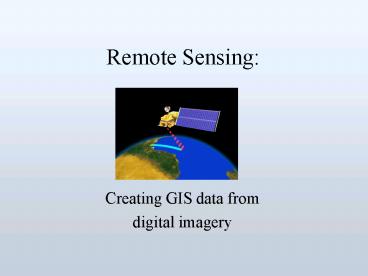Remote Sensing: - PowerPoint PPT Presentation
1 / 30
Title:
Remote Sensing:
Description:
'A means of acquiring information using airborne equipment and techniques to ... meaningful digital thematic map from a image data. set (information extraction) ... – PowerPoint PPT presentation
Number of Views:142
Avg rating:3.0/5.0
Title: Remote Sensing:
1
Remote Sensing
- Creating GIS data from
- digital imagery
2
- Remote Sensing Defined
- A means of acquiring information using airborne
equipment and techniques to determine the
characteristics of an area. Aerial photographs
from aircraft and satellite are the most common
form of remote sensing. - "Remote sensing is the science of deriving
information about the earth's land and water
areas from images acquired at a distance. It
usually relies upon measurement of
electromagnetic energy reflected or emitted from
the features of interest (Campbell 1987)."
3
- Types of GIS data created from remotely sensed
imagery - Land Cover Maps (physical material on earths
surface) - Agricultural Maps (Type of Land Cover)
- Digital Elevation Models
- -Delineate Watersheds, Streams Rivers, Flood
Plains - -Create Slope and Shaded Relief Maps
- Stream/Water Body Temperature
4
Multi-Spectral Remote Sensing
- Sensors, typically on Satellites or Airplanes,
record the intensity of EMR from the sun as it is
reflected and emitted from the earths surface. - These sensors record EMR (continuous data) into
discrete ranges of the Spectrum called channels
or bands. - Most Sensors operate in the visible to
near-infrared portion of the electro magnetic
spectrum.
5
The Electromagnetic Spectrum
Units Micron 10-6m Nanometer 10-9m
6
(No Transcript)
7
Spectra of earth materials When EMR from the sun
reaches the earth surface, it is transmitted -
transmittance absorbed - absorbance reflected
- reflectance The nature of how the earth
materials transmit, absorb or reflect the solar
EMR is called spectral signature of an object.
8
The Solar Spectrum at the Surface
9
Spectral Signatures The Principle of Spectral
Remote Sensing
0.4
1.0
10
(No Transcript)
11
12
(No Transcript)
13
Spatial Resolution Characteristics
14
Mixels
15
Resolution and Mixing
16
Resolution Comparison Landsat 7 (30m) vs. Ikonos
(1m)
17
Landsat Image of Greater Puget Sound
18
- Satellite Example Landsat
- Landsat 1 was launched on July 23, 1972.
- Landsat 7 is most current and was launched on
April 15, 1999. - Numerous technological improvements occurred with
each new sensor, including improved spectral and
spatial resolution. In general, comparable
temporal data exits as far back as March 1, 1984-
launch of Landsat 5. - Landsat 7 has a 16 day between scene interval.
19
- Benefits of Landsat
- Regional Coverage (large per scene spatial
extent) - Relatively inexpensive
- Seasonal/Temporal Availability
- Multiple bands facilitate accurate
classifications - Data Consistency(?)
20
Spectral Resolution Characteristics
21
- Types of errors and effects in digital images
- geometric distortions
- variations in solar illumination angle
- atmosphere (scattering absorption)
- topographic effect
22
- Effects of Noise in multi-temporal imagery
- An objects spectral response as recorded by the
sensor - will be different than if recorded at ground
level. - Material that has remained unchanged over time
- will have some degree of spectral variability
from image to - image.
- Analysts often attempt to correct images so that
they better represent - an objects true spectral response at a given sun
incident angle. A data - normalization procedure will typically attempt to
account for all - four factors mentioned on the previous slide.
23
Atmospheric Effects
24
Example Topographic Effect
Image data
Shaded relief model
25
Image classification Image classification is the
process of creating a meaningful digital
thematic map from a image data set (information
extraction). Supervised classification
classes from known cover types. Unsupervised
classification classes by algorithms that
search the data for similar pixels.
26
- Supervised classification
- Training class selection (training
areas/classes) - Generating statistical parameters (spectral
signatures) - of training classes
- Data classification
- Evaluation and refinement
27
(No Transcript)
28
(No Transcript)
29
(No Transcript)
30
Concluding Remarks































